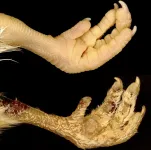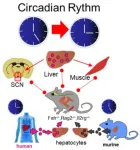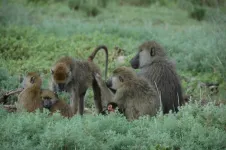(Press-News.org) MINNEAPOLIS – The number of deaths worldwide from ischemic stroke increased from 2 million in 1990 to more than 3 million in 2019, and is expected to increase to nearly 5 million by 2030, according to a study published in the May 17, 2023, online issue of Neurology®, the medical journal of the American Academy of Neurology. The study focused on ischemic stroke, which is caused by a blockage of blood flow to the brain and is the most common type of stroke.
“This increase in the global death toll of ischemic stroke along with a predicted further increase in the future is concerning, but ischemic stroke is highly preventable,” said study author Lize Xiong, MD, of Tongji University in Shanghai, China. “Our results suggest that a combination of lifestyle factors like smoking and a diet high in sodium along with other factors such as high blood pressure and high body mass index can lead to an increased risk of stroke.”
For the study, researchers analyzed data from the Global Health Data Exchange from 1990-2019. As the world population grew, the global number of ischemic stroke deaths increased from 2.04 million in 1990 to 3.29 million in 2019. However, the stroke rate decreased from 66 strokes per 100,000 people in 1990 to 44 strokes per 100,000 people in 2019.
“This decrease in the stroke rate likely means that the overall increase in the number of strokes worldwide is mainly due to population growth and aging,” Xiong said.
Researchers found that seven major risk factors including smoking, a diet high in sodium, high blood pressure, high cholesterol, kidney dysfunction, high blood sugar, and high BMI contributed to the higher number of strokes.
Researchers then used the database to predict the number of deaths for 2020-2030.
Researchers found that the death toll for ischemic stroke is expected to increase further to 4.9 million in 2030. When researchers factored in the risk factors, they predicted that the overall number of deaths from stroke could reach 6.4 million if these risk factors are not controlled or prevented.
“This study provides an insightful perspective on the global burden of ischemic stroke,” said editorial author Carlos Cantú-Brito, MD, PhD, from the Stroke Clinic of the Salvador Zubirán National Institute of Health Sciences and Nutrition in Mexico City, Mexico. “It points out many vital factors that should be used for informed policymaking, emphasizing the need for policies and programs to promote healthy lifestyle choices, including regular physical activity, low-salt diets, and smoking cessation.”
A limitation of the study was that quality and accuracy of disease data from some countries cannot be guaranteed as many did not have reliable information on strokes.
The study was supported by the Chinese Ministry of Science and Technology, Shanghai Fourth People's Hospital, Chinese National Key Research and Development Program, and Nature Science Foundation of Shanghai.
Learn more about stroke at BrainandLife.org, home of the American Academy of Neurology’s free patient and caregiver magazine focused on the intersection of neurologic disease and brain health. Follow Brain & Life® on Facebook, Twitter and Instagram.
When posting to social media channels about this research, we encourage you to use the hashtags #Neurology and #AANscience.
The American Academy of Neurology is the world’s largest association of neurologists and neuroscience professionals, with over 40,000 members. The AAN is dedicated to promoting the highest quality patient-centered neurologic care. A neurologist is a doctor with specialized training in diagnosing, treating and managing disorders of the brain and nervous system such as Alzheimer’s disease, stroke, migraine, multiple sclerosis, concussion, Parkinson’s disease and epilepsy.
For more information about the American Academy of Neurology, visit AAN.com or find us on Facebook, Twitter, Instagram, LinkedIn and YouTube.
END
Worldwide stroke deaths expected to increase to nearly 5 million by 2030
Ischemic stroke deaths increased by more than 1 million from 1990-2019
2023-05-17
ELSE PRESS RELEASES FROM THIS DATE:
An electric vehicle battery for all seasons
2023-05-17
Many owners of electric vehicles worry about how effective their battery will be in very cold weather. Now a new battery chemistry may have solved that problem.
In current lithium-ion batteries, the main problem lies in the liquid electrolyte. This key battery component transfers charge-carrying particles called ions between the battery’s two electrodes, causing the battery to charge and discharge. But the liquid begins to freeze at sub-zero temperatures. This condition severely limits the effectiveness of charging electric ...
One step closer to developing a potentially ultraprotective sunscreen from our own melanin
2023-05-17
A new discovery about the structure of melanin has brought scientists one step closer to developing a new, potentially ultra-protective sunscreen derived from a biological substance found in nearly all organisms. Researchers from McGill’s Department of Chemistry, in collaboration with The Ohio State University and the University of Girona, have announced a major advance in understanding the fundamental structure of melanin and one of its components that turns light into heat, protecting the body from sun damage.
Melanin, the pigment that gives humans their skin, eye, and hair colour, is the body’s first and best natural defense against the sun’s ...
Siblings can "pave the way" when they have a similar "Big Five" personality - with introverted siblings being more likely to leave home once their similarly introverted brother or sister has done so
2023-05-17
Siblings can "pave the way" when they have a similar "Big Five" personality - with introverted siblings being more likely to leave home once their similarly introverted brother or sister has done so
###
Article URL: https://journals.plos.org/plosone/article?id=10.1371/journal.pone.0284808
Article Title: Do birds of a feather leave the nest together? The role of sibling personality similarity in the transition to adulthood
Author Countries: Belgium.
Funding: This research has been made possible through the grant Nr. G017519N ...
Households whose "heads" score highly for openness and conscientiousness are more likely to make higher charitable donations, according to Chinese study incorporating "Big Five" personality traits
2023-05-17
Households whose "heads" score highly for openness and conscientiousness are more likely to make higher charitable donations, according to Chinese study incorporating "Big Five" personality traits
###
Article URL: https://journals.plos.org/plosone/article?id=10.1371/journal.pone.0284798
Article Title: A study on the influence of personality characteristics on household charitable donation behavior in China
Author Countries: China
Funding: Funding was provided by Shenzhen Key Research ...
Sustainable agriculture is building peace in Colombia
2023-05-17
In areas of Colombia once controlled by guerillas, conflicts over land continue and deforestation has risen considerably. But it’s in these same areas that researchers have found that farmers implementing sustainable land use systems, like agroforestry driven by cocoa (one of the key ingredients of chocolate), has contributed to reducing conflicts.
Deforestation and Conflict
In 2016, the government of Colombia signed a peace treaty with the guerilla group Revolutionary Armed Forces of Colombia (FARC, for its initials in Spanish) and in the following years, forested areas formerly controlled by the FARC saw an influx of other illegal actors, contributing ...
Australian nanomedicine research a ‘milestone’ in the treatment of childhood cancer
2023-05-17
Australian nanomedicine researchers have come up with a new approach to solving a decades-old clinical problem: getting treatment drugs to act selectively on cancer cells in the body. Published this week in the high-impact journal Science Translational Medicine, the research paves the way to safer and more effective treatment options for children with aggressive blood cancers, and potentially other types of cancer as well.
Chemotherapy is the mainstay of treatment for leukaemia, the most common blood cancer in children. However, while chemotherapy can be very effective for certain types of leukaemia, ...
Scales or feathers? It all comes down to a few genes
2023-05-17
Scales, spines, feathers and hair are examples of vertebrate skin appendages, which constitute a remarkably diverse group of micro-organs. Despite their natural multitude of forms, these appendages share early developmental processes at the embryonic stage. Two researchers from the University of Geneva (UNIGE) have discovered how to permanently transform the scales that normally cover the feet of chickens into feathers, by specificially modifying the expression of certain genes. These results, published in the journal Science Advances, open new perspectives for studying mechanisms that have enabled radical evolutionary ...
New study explains how a common virus can cause multiple sclerosis
2023-05-17
Researchers at Karolinska Institutet in Sweden have found further evidence for how the Epstein-Barr virus can trigger multiple sclerosis or drive disease progression. A study published in Science Advances shows that some individuals have antibodies against the virus that mistakenly attack a protein in the brain and spinal cord.
The Epstein-Barr virus (EBV) infects most people early in life and then remains in the body, usually without causing symptoms. The link between EBV and the neurological disease multiple sclerosis (MS) was discovered many years ago and has puzzled ...
Liver cells control our biological clock
2023-05-17
Organisms rely on a biological clock known as the ‘circadian’ clock to regulate their activity according to the time of day. A central clock, constituted by a group of brain cells — the suprachiasmatic nuclei, or SCN — synchronises the circadian clocks present in all body’s organs, called ‘peripheral’ clocks. Until now, synchronisation of the circadian cycle in mammals was thought to be a one-way mechanism in which the suprachiasmatic nuclei alone synchronized the peripheral ...
Adult friendships can triumph over childhood trauma, even in baboons
2023-05-17
DURHAM, N.C. -- Decades of research show that experiencing traumatic things as a child -- such as having an alcoholic parent or growing up in a tumultuous home -- puts you at risk for poorer health and survival later in life.
But mounting evidence suggests that forging strong social relationships can help mitigate these effects. And not just for people, but for our primate cousins, too.
Drawing on 36 years of data, a new study of nearly 200 baboons in southern Kenya finds that adversity early in life can take years off their lifespan, but strong social bonds with other baboons in adulthood can help ...
LAST 30 PRESS RELEASES:
Why nail-biting, procrastination and other self-sabotaging behaviors are rooted in survival instincts
Regional variations in mechanical properties of porcine leptomeninges
Artificial empathy in therapy and healthcare: advancements in interpersonal interaction technologies
Why some brains switch gears more efficiently than others
UVA’s Jundong Li wins ICDM’S 2025 Tao Li Award for data mining, machine learning
UVA’s low-power, high-performance computer power player Mircea Stan earns National Academy of Inventors fellowship
Not playing by the rules: USU researcher explores filamentous algae dynamics in rivers
Do our body clocks influence our risk of dementia?
Anthropologists offer new evidence of bipedalism in long-debated fossil discovery
Safer receipt paper from wood
Dosage-sensitive genes suggest no whole-genome duplications in ancestral angiosperm
First ancient human herpesvirus genomes document their deep history with humans
Why Some Bacteria Survive Antibiotics and How to Stop Them - New study reveals that bacteria can survive antibiotic treatment through two fundamentally different “shutdown modes”
UCLA study links scar healing to dangerous placenta condition
CHANGE-seq-BE finds off-target changes in the genome from base editors
The Journal of Nuclear Medicine Ahead-of-Print Tip Sheet: January 2, 2026
Delayed or absent first dose of measles, mumps, and rubella vaccination
Trends in US preterm birth rates by household income and race and ethnicity
Study identifies potential biomarker linked to progression and brain inflammation in multiple sclerosis
Many mothers in Norway do not show up for postnatal check-ups
Researchers want to find out why quick clay is so unstable
Superradiant spins show teamwork at the quantum scale
Cleveland Clinic Research links tumor bacteria to immunotherapy resistance in head and neck cancer
First Editorial of 2026: Resisting AI slop
Joint ground- and space-based observations reveal Saturn-mass rogue planet
Inheritable genetic variant offers protection against blood cancer risk and progression
Pigs settled Pacific islands alongside early human voyagers
A Coral reef’s daily pulse reshapes microbes in surrounding waters
EAST Tokamak experiments exceed plasma density limit, offering new approach to fusion ignition
Groundbreaking discovery reveals Africa’s oldest cremation pyre and complex ritual practices
[Press-News.org] Worldwide stroke deaths expected to increase to nearly 5 million by 2030Ischemic stroke deaths increased by more than 1 million from 1990-2019




